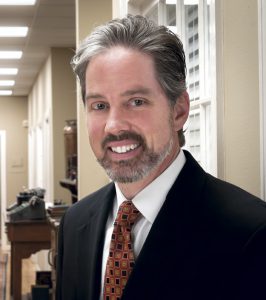Georgia agency sees benefits revenues increasing by30-plus percent a year, triple the rate of other lines
Arriving late to a party doesn’t necessarily mean that all the good hors d’oeuvres are taken. You might just avoid filling up on the ordinary snacks while the best are being baked.
Edward Smith, executive vice president of Hutchinson Traylor Insurance in LaGrange, Georgia, explains that, compared with other agencies in its region, his firm is relatively new to employee benefits. But arriving with fresh ideas and new funding techniques, the independent agency has been able to attract a wide range of employers—from small businesses to large manufacturers—that are looking for new ways to control their healthcare costs.
“Arriving late to the scene has allowed us to make a clean assessment of an employer’s challenges without the legacy relationships and conventional thinking that have kept many employers from moving ahead and using the latest techniques in alternative funding and healthcare cost management,” he says.
Solid business
Founded nearly a century ago by Charlie Traylor and Paul Hutchinson, the firm started as a property/casualty agency. The first car the duo insured was a Model-T Ford. Since then the West Georgia agency has grown steadily—both organically and by acquiring other agencies. Today, the firm operates out of offices in LaGrange, Atlanta, Columbus and Moultrie, Georgia.
In 1967, Charles W. Smith bought into the agency, working with Charlie Traylor’s nephew, L. Henderson Traylor. Smith maintained majority interest in Hutchinson Traylor until 1999, when ownership was purchased by his two sons, C. Wesley Smith Jr. and Edward. Today, the two brothers are the majority owners and operators of the business, with key personnel as minority equity partners.
Edward says the agency began employee benefits consulting in 2004, at a time when benefits had started to become a serious cost concern. “Employers were struggling to obtain the data necessary to understand what drove their costs, and this prevented them from actively managing their employee benefits,” he explains. “For many employers, benefits had risen to become the second or third highest business expense.”
Maintaining a robust employee benefits platform has continued to be a challenge. “Escalating costs have led employers to seek out innovative solutions,” Edward says. He points out that, for employers with 50 or fewer employees, not a lot can be done to contain cost. “For the most part, they are limited to fully insured health plans with perpetually increasing community rates.”
More options exist for larger employers. For them, Smith says, “We are guides. Our team defines the problem and brings a quiver of innovative strategies that are proven to reduce cost while improving patient outcomes and overall experience.” The agency has outcomes data illustrating its success in doing just that.
Hutchinson Traylor has grown into a leader in its region. For instance, the agency has earned recognition as a 2016 Best Practices Agency by the Independent Insurance Agents & Brokers of America. The award is given to only a small, elite group of top-performing agencies in the country.
Today, employee benefits is Hutchinson Traylor’s fastest-growing business. Overall agency revenue has been increasing at a rate of 10% annually, but benefits revenues have been increasing much faster—from 28% to 35% a year, Edward notes. Commercial property/casualty insurance continues to be the largest component of revenue, at about 50% of the total. But benefits have increased to 25%, equal to personal lines revenue.

-Edward Smith
Executive Vice President
The agency offers a wide range of benefit advisory services, from insurance products to human resources consulting and technology to high-performance network design and provider contract negotiation. Medical management, population health management, prescription drug optimization, analytics, and a member engagement platform also are part of the mix.
Of the agency’s 50 employees, a dozen or so work in benefits services. Leading health plans in the agency’s market territory include Humana, BlueCross/BlueShield, United Healthcare and Aetna Health.
Mike Stone, employee benefits account executive, often makes initial contact with prospective clients and conducts the first diagnosis of employee benefits needs. “Our clients are challenged with some unique concerns in cost, coverage and control. Cost factors require a special approach for each client.”
He points out that the consolidation of health insurers and a rate environment that allows annual double-digit increases have combined to persuade employers to be more accepting of alternative funding strategies, such as level funding, partially self-funding, or benefit captive arrangements.
“But while costs are the big driver that leads employers to self-funding strategies, control is the deciding factor,” Stone explains. “Employers are more likely to change their funding platform if risk mitigation strategies can be deployed to help control costs over the long term.”
Stone points out that employers with 75 to 200 employees have more options for self-funding than ever before. The stop loss insurance marketplace creates opportunities for small employers to fund a portion of their costs and still protect against catastrophic claims. Hutchinson Traylor has been able to put small employer risks into group self-funding programs by using cost containment techniques such as customized network and prescription drug contracts and benefit captives.
He says the agency consolidates clients into a domestic-domiciled captive that allows participants to customize their own funding and risk mitigation platforms. These employers are positioned to reduce their long-term costs with employee wellness programs that target the employers’ biggest cost drivers, including chronic conditions that can be better managed to avoid later catastrophic claims.
Carving out pharmacy benefits also can yield some immediate savings. “There’s a lot of low-hanging fruit in prescription drug costs and the ability to negotiate a transparent pharmacy benefit manager relationship,” Stone says. “Pharmacy benefit managers have come under a lot of scrutiny for cost management issues. Our firm has a very effective prescription drug program that we implement for the clients of third-party administrators and other brokers as often, as we do for our own employer clients.”
Stone says the process of moving employers from fully insured to some form of self-funding can take as long as six months. How do they do it? “Education, education, education,” he says. “That’s what we have to do up front. We have to explain exactly how alternative strategies work.”
He adds, “Once employers are confident in their understanding of the process, we can proceed to help them understand that self-funding is more than an insurance decision. It is a long-term economic policy that requires a commitment at the highest levels, but it’s one that can yield substantial rewards.”
The 2016 year-end renewal period brought substantial interest in benefit alternatives from current and new customers, he says, and much of the interest came from the chief financial officer level. That’s because financial leaders are more likely to seek more control over the cost of benefits in general and rising healthcare costs specifically.
Beyond the sale
Erica Moncus, benefits division lead, often accompanies account executives to the initial meetings with new and prospective clients. Service is critical, she says, and Hutchinson Traylor’s reputation for creativity in employee benefits in part is driven by the continuity of service the agency provides through its dedicated account managers.
Like most account management departments, Hutchinson Traylor’s staff members handle a range of service tasks, such as enrollment—both onsite and online—billing, educationand claims. The account managers also contribute to the implementation of various strategies and tactics—everything from setting up captive participation to analyzing claims data and more.
“The biggest differentiator we have is our creativity, and our in-office organization reflects this,” Moncus explains. In the LaGrange office, for example, “We are all within earshot. No one is ever in a box.” The agency’s open-office arrangement allows all of the account management staff members to stay in constant communication.
Moncus says the whole benefits department meets biweekly, bringing in staff from other offices to share ideas and observations about clients and their programs. “One of the best things I can say about our staff is that they like to come to work,” she says. “That’s not the case with every employer. The Hutchinson Traylor management style creates opportunities for everyone to be creative and contribute to the success of our clients.”
Account management team members also maintain regular communication with clients, meeting several times a year after renewal to provide benchmarks and updates on the plan’s status and goals.
Added offerings
The agency also sets itself apart with the population health management services it provides its clients, including destination medicine, Rx tourism, on-site clinics and WellTree, a suite of medical advocacy and telemedicine services. WellTree provides 24/7 access to a U.S. licensed physician who can supplement an employee’s primary medical care.
According to Smith, the service, which is provided by Teladoc, Inc., in Lewisville, Texas, and private labeled for the agency, can be a good companion to high-deductible health plans. “Employees can access the service without office visit fees or deductibles, and can receive medical advice and routine prescriptions through it,” he says. “Employers can provide the service and explain to their workers that, even though deductibles and costs have increased, the employer wants to make sure they receive quality care.”
The agency also has installed three on-site clinics, including one at the local Kia Motors manufacturing facility. “The on-site clinics are somewhat expensive to get started,” Smith observes. “But once they are in place, they can deliver a significant return on investment to the employer while improving population health. They tend to have high utilization, and they provide front-line health services to employees, giving them an opportunity to get regular medical tests and maintain care for both regular and chronic health concerns.”
Human resources consulting also is among the agency’s offerings. Dorothy Edmonds, a full-time employee who holds the Senior Professional in Human Resources (SPHR) professional designation, provides human resources support for clients and installs and maintains HR technology and databases.
“Human resources support as become a standard service inmany benefit agencies,” Smith says. “When an employer struggles during a faltering economy, human resources typically is one of the first administrative departments to be understaffed. It is only natural for clients to come to us for the help and support they need.”
For more information:
Hutchinson Traylor
www.hutchinsontraylor.com
The Author
Len Strazewski is a Chicago-based writer, editor and educator specializing in marketing, management and technology topics. In addition to contributing to Rough Notes, he has written on insurance for Business Insurance, Risk & Insurance, the Chicago Tribune and Human Resource Executive, among other publications.






